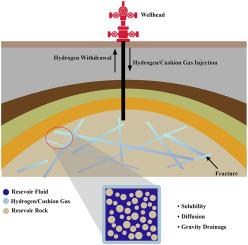天然裂缝性储层地下储氢:缓冲气选择的矩阵尺度模型
IF 8.3
2区 工程技术
Q1 CHEMISTRY, PHYSICAL
引用次数: 0
摘要
氢是未来关键的零碳燃料,但生产和能源需求的季节性波动需要有效的储存解决方案。在天然裂缝性储层(nfr)中,地下储氢(UHS)是一种很有前途的方法,因为它们具有安全保存流体的能力。本研究使用单基质块(SMB)模型模拟了UHS,以探索NFR中气体和水侵部分的氢气储存,以及是否使用缓冲气体(CO2, CH4, N2)。缓冲气体在氢气提取过程中提供压力支撑,防止氢气与储层流体直接接触。结果表明,在无缓冲气的情况下,气侵SMB和水侵SMB可分别储存150 m3和65 m3的氢气。在水侵区使用二氧化碳作为缓冲气体,使储氢容量增加了三倍。相反,在气体侵入区,根据缓冲气体类型的不同,储氢容量降低了12-18%。缓冲气体也减少氢在液体中的溶解,这有助于氢的损失。CH4对降低氢损失最有效,气侵SMB的氢损失从11.61 m3降至8.64 m3,水侵SMB的氢损失从23.73 m3降至18.68 m3。这些发现表明,虽然缓冲气体在高压气占主导地位的地层中可能是可选的,但它们对于在含水层和液体饱和储层中有效的超高压至关重要。本文章由计算机程序翻译,如有差异,请以英文原文为准。

Underground hydrogen storage in naturally fractured reservoirs: Matrix scale modeling for cushion gas selection
Hydrogen is a key zero-carbon fuel for the future, but seasonal fluctuations in production and energy demand require effective storage solutions. Underground hydrogen storage (UHS) in naturally fractured reservoirs (NFRs), such as depleted hydrocarbon reservoirs, is a promising approach due to their proven ability to keep fluids securely. This study simulates UHS using a single matrix block (SMB) model to explore hydrogen storage in gas and water-invaded parts of an NFR, with and without the use of cushion gases (CO2, CH4, N2). Cushion gases provide pressure support during hydrogen withdrawal and prevent direct contact between hydrogen and reservoir fluids. The results reveal that 150 m3 and 65 m3 of hydrogen can be stored in a gas and water-invaded SMB, respectively, without cushion gas. The use of CO2 as a cushion gas in water invaded zone resulted in a three-fold increase in hydrogen storage capacity. In contrast, in gas invaded zone, hydrogen storage capacity decreased by 12–18%, depending on the type of cushion gas used. Cushion gases also reduce hydrogen dissolution in liquids, which contributes to hydrogen loss. CH4 was the most effective in reducing hydrogen loss, lowering it from 11.61 m3 to 8.64 m3 in gas-invaded SMB and from 23.73 m3 to 18.68 m3 in water-invaded SMB. These findings indicate that while cushion gases may be optional in high-pressure gas-dominated formations, they are essential for efficient UHS in aquifers and liquid-saturated reservoirs.
求助全文
通过发布文献求助,成功后即可免费获取论文全文。
去求助
来源期刊

International Journal of Hydrogen Energy
工程技术-环境科学
CiteScore
13.50
自引率
25.00%
发文量
3502
审稿时长
60 days
期刊介绍:
The objective of the International Journal of Hydrogen Energy is to facilitate the exchange of new ideas, technological advancements, and research findings in the field of Hydrogen Energy among scientists and engineers worldwide. This journal showcases original research, both analytical and experimental, covering various aspects of Hydrogen Energy. These include production, storage, transmission, utilization, enabling technologies, environmental impact, economic considerations, and global perspectives on hydrogen and its carriers such as NH3, CH4, alcohols, etc.
The utilization aspect encompasses various methods such as thermochemical (combustion), photochemical, electrochemical (fuel cells), and nuclear conversion of hydrogen, hydrogen isotopes, and hydrogen carriers into thermal, mechanical, and electrical energies. The applications of these energies can be found in transportation (including aerospace), industrial, commercial, and residential sectors.
 求助内容:
求助内容: 应助结果提醒方式:
应助结果提醒方式:


